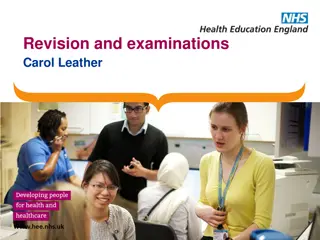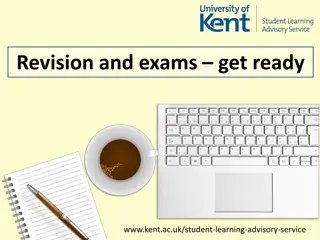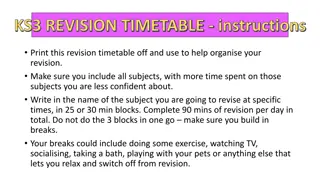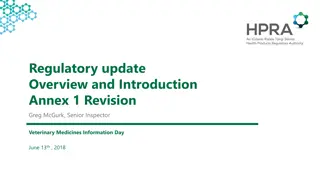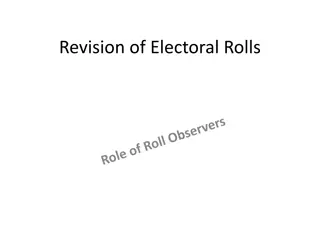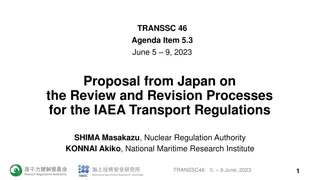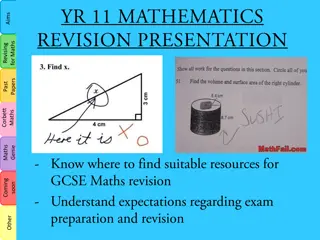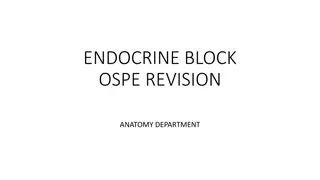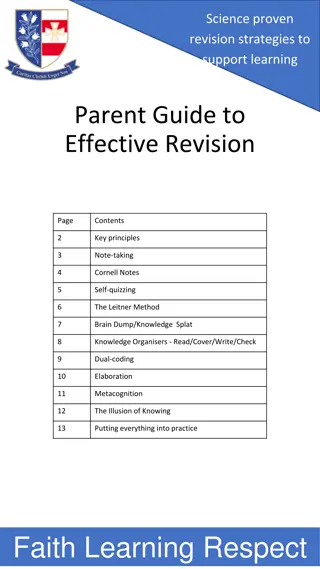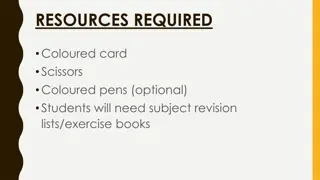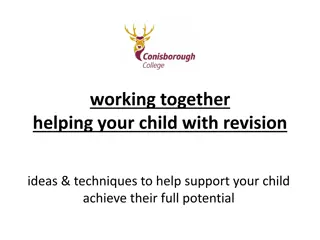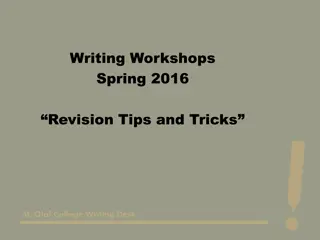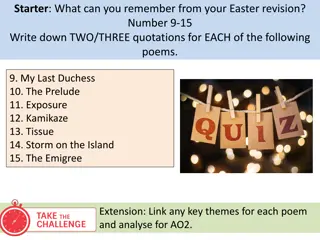Year 9 End of year revision
Learn how plants make their own food and the essential processes of photosynthesis. Discover why photosynthesis is crucial for maintaining oxygen and carbon dioxide levels. Explore leaf structure, chloroplast function, roles of carbon dioxide and water, and the significance of light energy. Uncover the production of oxygen, glucose, and plant oils through photosynthesis. Understand the critical roles of water absorption, cell structures, food security, and pollination. Compare photosynthesis and respiration processes, and delve into the importance of carbon dioxide diffusion, stomata regulation, and cellular energy processes. Dive deeper into plant biology and energy production in this comprehensive revision.
Download Presentation

Please find below an Image/Link to download the presentation.
The content on the website is provided AS IS for your information and personal use only. It may not be sold, licensed, or shared on other websites without obtaining consent from the author.If you encounter any issues during the download, it is possible that the publisher has removed the file from their server.
You are allowed to download the files provided on this website for personal or commercial use, subject to the condition that they are used lawfully. All files are the property of their respective owners.
The content on the website is provided AS IS for your information and personal use only. It may not be sold, licensed, or shared on other websites without obtaining consent from the author.
E N D
Presentation Transcript
Oak Academy Review Lesson Links 9BP: Plants and Photosynthesis https://classroom.thenational.academy/lessons/mid-topic-review-60tk0t https://classroom.thenational.academy/lessons/review-part-2-ccw66d 9BB: Biological Systems and Processes https://classroom.thenational.academy/lessons/review-one-c4r36c https://classroom.thenational.academy/lessons/review-two-c4t3at 9PS: Sound https://classroom.thenational.academy/lessons/review-part-1-64t64d https://classroom.thenational.academy/lessons/review-part-2-6cr66t 9PM: Matter https://classroom.thenational.academy/lessons/matter-revision-part-1-6xjkje https://classroom.thenational.academy/lessons/matter-revision-part-2-60uket 9CR: Reactivity: https://classroom.thenational.academy/lessons/review-part-1-chjpcc https://classroom.thenational.academy/lessons/review-part-2-6tj6ad 9CE: Energetics and Rates https://classroom.thenational.academy/lessons/review-part-1-crvp4r https://classroom.thenational.academy/lessons/review-part-2-6rtked
Photosynthesis Plants make their own food (for energy) in a process called photosynthesis. Photosynthesis helps keep: levels of oxygen high; levels of carbon dioxide low. Feature of plant leaf Function Thin Short distance for carbon dioxide to diffuse into the leaf Waxy Layer Prevents water loss by evaporation Palisade cells Contain a lot of chloroplasts to absorb light Chloroplasts contain chlorophyll Absorbs light Photosynthesis takes place in the chloroplasts. Chloroplasts contain chlorophyll which absorbs the energy transferred by light waves for photosynthesis Allows carbon dioxide to diffuse into the leaf (and oxygen to diffuse out) Stomata The equation for photosynthesis is: carbon dioxide + water glucose + oxygen Guard cells Open/close stomata depending on conditions Network of tubes (xylem & phloem) Transports water (xylem) and food (phloem) These are the things that plants need for photosynthesis: carbon dioxide absorbed through their leaves; Water - from the ground through their roots; light (a source of energy) - from the Sun. 9BP: Plants and photosynthesis These are the things that plants make by photosynthesis: Oxygen - released into the air from the leaves; Glucose: turned into starch and plant oils, used as an energy store; This energy is released by respiration; Used to make cellulose for cell walls. Water Water is absorbed through the roots, by osmosis; It is transported through tubes (xylem) to the leaf; The roots contain cells called a root hair cells: They increase the surface area They have thin walls to let water pass into them easily. They do not contain chloroplasts. Food security and pollination Pollination is the transfer of pollen from one plant to another; Pollen can be transferred by insects or by wind; Insects that pollinate plants help us produce our food. Our food supply depends on plants: Our food made of, and from plants; The animals we eat feed on plants. Respiration v photosynthesis Photosynthesis: carbon dioxide + water glucose + oxygen Aerobic respiration is: glucose + oxygen carbon dioxide + water The equation for photosynthesis is the opposite of the equation for aerobic respiration. Photosynthesis: produces glucose and oxygen; uses carbon dioxide and water; Respiration: produces carbon dioxide and water; uses glucose and oxygen; Carbon dioxide Enters leaf by diffusion through the stomata. Guard cells control the size of the stomata Stomata closes in hot, windy or dry conditions. Spongy layer has gaps between cells; Allows carbon dioxide to diffuse to other cells in the leaf; Allows oxygen produced in photosynthesis diffuse out of the leaf. Water is absorbed into the roots by a process called osmosis, which does not use energy. Minerals areabsorbedinto the roots by a process called activetransport, which uses energy.
Photosynthesis 1. Write the missing words Plants make their own food (for energy) in a process called _________________. Photosynthesis helps keep: levels of oxygen ________; levels of carbon dioxide _______. Feature of plant leaf Function Short distance for carbon dioxide to diffuse into the leaf Waxy Layer Palisade cells Chloroplasts contain chlorophyll 2. Where does photosynthesis takes place? Allows carbon dioxide to diffuse into the leaf (and oxygen to diffuse out) 3. Name the green chemical inside chloroplasts? Open/close stomata depending on conditions Network of tubes (xylem & phloem) 4. What is the function of this green chemical? 9BP: Plants and photosynthesis Food security and pollination 1. What is pollination? 5. Write the word equation for photosynthesis 2. Which group of organisms are involved in pollination? 6. Name the 3 things needed for photosynthesis Water 1. Name the cells found in the roots? 7. Describe 3 ways plants use glucose made from photosynthesis 2. Describe how root hair cells are adapted for water absorption? 3. How else can pollen be transferred? 3. Name the cell structure missing from root hair cells 4. Explain why pollination is important? 1. What is absorbed by the roots? By which process is this absorbed into the roots? Respiration v photosynthesis 1. Write the word equation for respiration Carbon dioxide 1. State the 3 weather conditions that closes the stomata 2. How is photosynthesis different to respiration? 2. Name the process by which minerals are absorbed into the roots? 2. Name the gases that diffuse through the spongy layer 3. Which process uses carbon dioxide and water? 3. In which direction does the carbon dioxide diffuse? 3. How is the process mentioned in question 2 different from the process mentioned in question 1? 4. Which process uses glucose and oxygen? 4. In which direction does the oxygen diffuse?
The human gas exchange system Oxygen is needed for respiration; Carbon dioxide produced in respiration needs to be removed; Gas exchange ismovingoxygen from the air into the blood, and removing waste carbon dioxide from the blood into the air. Anaerobic respiration In humans: The equation for anaerobic respiration in humans is: glucose lactic acid Lactic acid builds up in the muscles; Causing pain and tiredness (fatigue); Can lead to cramp; Lactic acid is broken down when you start aerobic respiration again. Aerobic respiration Energy is needed for: growth and repair movement control of body temperature in mammals/birds The respiratory system contains the organs that allow us to get the oxygen we need and to remove the waste carbon dioxide we do not need: Air passes from the mouth into the trachea (windpipe); The trachea divides into two bronchi - one for each lung. Each bronchus divides into smaller tubes called bronchioles. At the end of each bronchiole, there are air sacs (alveoli) The alveoli increase the surface of the lungs. The equation for aerobic respiration is: glucose + oxygen carbon dioxide + water Glucose and oxygen react to produce carbon dioxide and water and release energy; It is aerobic respiration because oxygen is used; Respiration happens in all living cells, including plant and animal cells; Takes place in the mitochondria of the cell; Energy is released from glucose; Do not confuse respiration with breathing (which is called ventilation). Fermentation The equation for anaerobic respiration in yeast is: glucose ethanol + carbon dioxide Anaerobic respiration happens in microbes (eg bacteria); They need to release energy from glucose; Yeast (unicellular fungi) can carry out an anaerobic process called fermentation; Ethanol (alcohol) is produced; The ethanol is used to make beer and wine; The carbon dioxide helps bread rise. Features of the alveoli Increase surface area of lungs; Moist, thin walls (just one cell thick); A lot of tiny blood vessels called capillaries The gases move by diffusion (from a high concentration to a low concentration): oxygen diffuses from the air into the blood; carbon dioxide diffuses from the blood into the air. 9BB Aerobic Anaerobic Biological systems and processes Needs oxygen? Yes No Ventilation Ventilation is another word for breathing; It involves movements of the ribs, intercostalmuscles and diaphragm to move air in and out of the lungs: inhale breathing in; exhale breathing out; Needs glucose? Yes Yes Carbon dioxide and water Product(s) formed Lactic acid Energy released More Less Impact of exercise - exercise causes an increase in: breathing rate; tidal volume (volume of air breathed in/out in one breath); Regular exercise can increase the: strength of the diaphragm and intercostalmuscles; vital capacity (volume of air that can be forcibly exhaled after inhaling fully).
The human gas exchange system 1. Which gas is needed for respiration? Aerobic respiration 1. Write 3 ways energy is used Anaerobic respiration 1. Write the word equation for anaerobic respiration in humans. 2. Name the gas produced in respiration needs to be removed; 2. Name the chemical that builds up in the muscles during anaerobic respiration. 3. What is gas exchange? 2. Write the word equation for aerobic respiration 4. Complete the passage Air passes from the mouth into the ________ (windpipe); The trachea divides into two ___________ - one for each lung. Each bronchus divides into smaller tubes called ___________. At the end of each bronchiole, there are air sacs (_________) The alveoli increase the __________ of the lungs. 3. What does the build up of this chemical cause? 3. Why is the equation in question 2 called aerobic question? 4. What can be done to break down this chemical built up in the muscles? 4. Where does respiration take place in cells? 5. Write the word equation for anaerobic respiration in yeast Features of the alveoli 1. Describe the features of the alveoli 5. What is released during respiration? 6. What is the name for this type of respiration? 7. Describe how ethanol and carbon dioxide is used in the food industry. 2. What is diffusion? 9BB 3. In which direction does oxygen diffuse? Biological systems and processes 4. In which direction does the carbon dioxide diffuse? Aerobic Anaerobic Needs oxygen? Yes No Needs glucose? Yes Yes Carbon dioxide and water Product(s) formed Lactic acid Energy released More Less Impact of exercise 1. How does exercise affect the breathing rate and tidal volume? 2. Describe the impact of regular exercise
Smoking Smoking is very harmful to health. Smoke contains harmful substances. These include: tar nicotine carbon monoxide Stimulants Stimulants speed up messages in the brain and along the nerves. Legal Stimulants Nicotine and caffeine are legal stimulants; Caffeine is found in cola drinks, coffee and tea; Caffeine makes you feel more alert, but it can cause insomnia (difficulty in sleeping), headaches and nervousness; Drugs Drugs are a substance that has an effect on the body. They can be: medicines are drugs that treat pain or disease; recreationaldrugs are taken because people like the effects they have on their bodies. Tar causes cancer of the lungs, mouth and throat; coats the inside of the lungs causing coughing; damages the alveoli, making gas exchange difficult. Some recreational drugs are legal, eg caffeine, tobacco & alcohol; Most recreational drugs are illegal, eg cannabis, ecstasy and heroin; Recreational drugs can be classified as a depressant or a stimulant; Most recreational drugs can be addictive. Illegal Stimulants Cocaine, ecstasy and amphetamines are all illegal stimulants; Cocaine, ecstasy and amphetamines make you feel more energetic and confident, but damage the liver and heart; They cause loss of memory and concentration, and increase risk of mental illness; Smoke Cells in the trachea, bronchi and bronchioles produce mucus; Mucus traps dirt and microbes; Cells with cilia move the mucus out of the lungs; Smoke and tar damages the cilia; Smokers cough to move the mucus and are more likely to get bronchitis. Depressants Depressants slow down messages in the brain and along the nerves; alcohol, heroin and solvents are depressants 9BB Nicotine Nicotine is addictive; Nicotine increases heart rate and blood pressure, and makes blood vessels narrower; This can lead to heartdisease. Biological systems and processes Here are some of the typical effects depressants have on the body: feelings of well-being; lowered inhibition; slowed thinking; slowed muscular activity; a distorted view of the world, or hallucinations. Asthma Asthma affects the bronchioles; Airways can become inflamed, swollen and constricted (narrowed); excess mucus is produced. Carbon monoxide Carbon monoxide takes the place of oxygen in red blood cells; This reduces amount of oxygen that the blood can carry; It means the circulatory system has to work harder, causing heart disease. Long-term effects of depressants: damage to the liver, brain and heart; alcohol can cause weight gain; solvent abuse causes a rash around the nose and mouth; loss of memory and concentration; increased risk of mental illness. During an asthma attack: the lining of airways becomes inflamed; fluid builds up in the airways; muscles around bronchioles contract, which constricts airways. Smoking and pregnancy Smoking can damage the foetus during gestation. For example, it can: increase the risk of complications in pregnancy and birth; make it less likely to have a healthier pregnancy and a healthier baby increase the risk of stillbirth; make it more likely to be born too early; be more likely to be born underweight. Symptoms are: wheezing, tightchest and difficultybreathing. treated using drugs called relievers whichrelax and open up the airways. Any drug that is misused can cause damage to the body, as well as personal and social problems. Injecting drugs with syringes that someone else has used may lead to diseases such as HIV and hepatitis. Relievers are often administered using an inhaler,tobreathe the medicine in directly into your lungs.
Tar 1. Drugs 1. Stimulants 1. What is a stimulant? Describe 3 effects of Tar in the lungs What are drugs? 2. Explain how medicines are different from recreational drugs? 2. Give 2 examples of legal stimulants Smoke 1. What is produced by the cells in the trachea? What is it s function? 3. Give 2 examples of illegal stimulants 2. What moves the mucus out of the lungs? 3. Give 2 examples of legal recreational drugs 3. What does the smoke and tar damage? What effects does this have? 4. Describe the effects and causes of caffeine? 4. Give 2 examples of illegal recreational drugs? Nicotine 1. 5. Describe the effects and causes of amphetamines Why is smoking difficult to give up? 2. Describe the effects of nicotine on heart rate, blood pressure and blood vessels. 9BB Depressants 1. Describe the effects of depressants on the brain and nerves Biological systems and processes 3. What can the effects in question 2 lead to? Asthma 1. 2. Describe 4 typical effects depressants have on the body. Which part of the respiratory system is affected by Asthma? Carbon monoxide 1. What does carbon monoxide take the place of in red blood cells? 2. Describe what happens during an asthma attack? 2. How does affect the amount of oxygen carried around the body? 3. Describe 4 Long-term effects of depressants 3. What can it lead to? 3. What are the symptoms of Asthma? Smoking and pregnancy 1. Describe 4 risks of smoking during pregnancy 4. Name the drugs used to treat Asthma. Explain how they work? 5. How are these drugs administered?
Muscles and movement Muscles work by getting shorter - they contract; Muscles are attached to bones by strong tendons. During muscle contraction, it pulls on the bone, moving it. Joints The skeleton Bone is a living tissue with a blood supply. It is constantly being dissolved and formed It can repair itself if a bone is broken. Calcium and other minerals make bone strong but slightly flexible. Most joints allow parts of the skeleton to move; The human skeleton has joints called synovial joints. Antagonistic muscles Muscles can only pull, they cannot push; Muscles work in pairs, called antagonistic muscles; Four functions of the skeleton: 1) Support the body The skeleton supports the body. For example, without a backbone we would not be able to stay upright. 2) Protection of vital organs the skull protects the brain the ribcage protects the heart and lungs the backbone protects the spinal cord 3) Movement Bones are linked together by joints; Some are fixedjoints eg in the skull; Some are flexiblejoints eg the knee; Muscles move bones attached by joints. 4) Making blood cells Two main types of blood cell: red blood cells, which carry oxygen; white blood cells, which destroy harmful microbes (pathogens); Both are made in the bone marrow - soft tissue inside large bones protected by the hard part of the bone around it. Your elbow joint has two muscles that move your forearm up or down. These are the biceps and the triceps: to raise the forearm, the biceps contracts and the triceps relaxes; to lower the forearm again, the triceps contracts and the biceps relaxes. The synovial joint The ends of the bones in a joint are covered with a tough, smooth substance called cartilage. This is kept slippery by a liquid called synovialfluid. Tough ligaments join the two bones in the joint; If two bones moved against each other, without cartilage they would eventually wear away; This is called arthritis. Muscles exert a force on bones when they contract. You could work out the force exerted by the biceps muscle using the idea of moments. The way in which muscles and bones work together to exert forces is called biomechanics. 9BB Biological systems and processes
Joints 1. Muscles and movement 1. What do muscles do to work? The skeleton 1. State the 4 functions of the skeleton What is the name given to human skeleton joints? 2. What attaches muscles to bones? 2. Which organs does the ribcage protect? 3. Describe what happens when a muscle contracts. 3. What are the 2 main types of blood cells? Describe their function? 4. What can t muscles do? 5. What do you call muscles that work in pairs? 4. Where are these blood cells made? 6. Describe how the biceps and triceps work to raise the forearm 9BB 2. Name the tough smooth substance that is found at the ends of the bones in a joint? 7. Describe how the triceps and biceps work to lower the forearm Biological systems and processes 3. Name the fluid that keeps the cartilage slippery? 8. What do you call the way in which muscles and bones work together to exert forces? 4. What joins the two bones in the joint? 5. What would happen ff two bones moved against each other, without cartilage? What is this condition called?
Key terms Definition Structure of DNA Genetic information is passed from one generation to the next. This is called heredity and why we resemble our parents. the pair of nitrogenous bases that connects the (complementary) strands of DNA; Base Pair Bond the chemical link that holds molecules together; The genetic information itself is contained in a complex molecule called DNA. Chromosome strands of DNA; Deoxyribonucleic acid. The chemical carrying the genetic code; DNA Scientists worked out the structure of DNA in the 1950s. Rosalind Franklin made X-ray diffraction images of DNA. the shape of DNA molecule, two strands twisted in a spiral; Double helix a section of DNA which we inherit from our parents, and which controls part of a cell's chemistry (protein production); Gene genetic information that determines an organism's characteristics, passed on from one generation to another. Heredity controls what happens inside the cell, and contains chromosomes Nucleus 9BB Biological systems and processes Chromosomes, DNA and genes The DNA in all of your cells is approximately two metres long, except for: Red blood cells which have none; Sperm or eggs only have about one metre. James Watson and Francis Crick used information from one of her images to work out a model for the structure of DNA. Work by Maurice Wilkins, a colleague of Franklin, supported their model. It is coiled into structures called chromosomes. Chromosomes are found in the nucleus of each cell. Human body cells each contain 23 pairs of chromosomes; Half of which are from each parent; Human gametes (eggs and sperm) each contain 23 chromosomes; When an egg is fertilised by a sperm, it becomes a cell with 23 pairs of chromosomes; We each have half of our chromosomes and DNA come from each parent; DNA makes up genes, which makes up chromosomes. One copy of all your chromosomes is called your genome. Watson and Crick were able to work out how DNA was arranged. They worked out that: DNA has two strands; the strands are twisted to form a double helix; the strands are held together by bonds between base pairs.
Structure of DNA 1. What does the term hereditary mean? Key terms Definition the pair of nitrogenous bases that connects the (complementary) strands of DNA; Base Pair 2. What do you call the complex molecule that holds the genetic information? Bond the chemical link that holds molecules together; 3. Name the type of images of DNA produced by Rosalind Franklin. Chromosome strands of DNA; Deoxyribonucleic acid. The chemical carrying the genetic code; DNA 4. Name the scientists who used the image to work out a model for the structure of DNA 9BB Double helix the shape of DNA molecule, two strands twisted in a spiral; Biological systems and processes Structure of DNA 1. What were the 3 main features of DNA discovered by Watson and Crick? Chromosomes, DNA and genes 1. Name the cell in the human body that does not contain DNA. a section of DNA which we inherit from our parents, and which controls part of a cell's chemistry (protein production); Gene 2. What do you call the coiled DNA structures? 3. Where are chromosomes found? 4. How many pairs of chromosomes are there in each body cell? genetic information that determines an organism's characteristics, passed on from one generation to another. Heredity 5. How many chromosomes are found in a human gamete? 6. How do human inherit these pairs of chromosomes? 7. How do gametes gain 23 pairs of chromosomes? controls what happens inside the cell, and contains chromosomes Nucleus 8. What is a genome?
Diffusion Eukaryotic Cells They have a nucleus to contain the chromosomes. These can be animal, plant or fungus or protist cells. Animal and plant cells are shown below. Cell Features Substances move a higher concentration of that substance (red particles pictured) to where there is a lower concentration of that substance. (High Low) This happens because of the random movement of the particles in a fluid (liquid or gas). Sperm High number of mitochondria Ribosomes that make enzymes in the head Nerve Long Lots of branches (dendrites) Animal There are ways the rate of diffusion can be changed: the difference in concentrations (concentration gradient) the temperature the surface area of the membrane Muscle High number of mitochondria High Number of ribosomes Store glycogen Xylem Walls thickened with lignin to strength the cells into a tube Phloem Sections between cells called sieves to help transport substances like dissolved sugars Plant RP1 Microscopy; Observing Plant Cells Preparing the slide: 1. Place a thin layer of onion membrane on a glass slide with forceps. 2. Use a drop of iodine to stain the cells. 3. Gently place a glass cover slip over the same and tap carefully to remove air bubbles. Root hair Large surface area Lack of chloroplasts Large vacuole Examples Alveoli in the lungs and villi in the small intestine are both structured in similar ways so diffusion can happen at a high rate (fast). having a large surface area a membrane that is thin, to provide a short diffusion path (in animals) having an efficient blood supply Microscopes The development of microscopes of the last 200 years has allowed us to study cells and the structures inside them in more and more detail. Calculating Magnification Units for image and actual size may need to be converted before using the equation below. Viewing the slide: 1. Place the slide on the stage and turn on the light. 2. Select the lowest magnification objective lens. 3. Look through the eyepiece and turn the coarse focus until the image can be seen. 4. Turn the fine focus until a clear image is formed. 5. Change the objective lens to another with a higher magnification and turn the fine focus re-focus the image. ????? ???? ?????? ???? ????????????? = mm m m mm x 1000 1000
1. Name the three cell parts (organelles) found in a plant cell but not in an animal cell. 1. How is a root hair cell specialised? 1. What factors affect the rate of diffusion? 2. How can you identify an eukaryotic cells from its structure? 2. Why would a cell contain more mitochondria than usual? 2. Give an example in animals where diffusion would take place? 3. What is the role of a ribosome? 3. Describe the structure of phloem cells. 4. Which organelle releases energy through respiration? 3. How are structures in organisms adapted for efficient diffusion? 4. How are nerve cells specialised? 5. What is the role of the cell wall? 5. Why does a sperm cell require a lot of mitochondria? 1. Which part of a light microscope is the glass slide placed on? 6. How are xylem cells specialised? 4. Do substances more from a low concentration to a high concentration 2. Which objective lens is selected first to produce a magnified image of a sample? 1. What are the advantages of using a electron microscope for viewing cells? 3. What is used to stain plant cells? 2. Convert 2.3mm into m. 4. What is place on top of the slide, sample and stain? 3. How would we calculate the actual size of a cell using the image size and magnification? 5. What part of the microscope is used to focus the image and make it clear? 4. Convert 570 m into mm.
Water waves Water waves move with a transverse motion The undulations (up and down movement) are at 90 to the direction of travel. Water waves, like all waves, can be reflected, refracted and diffracted. Ultrasound Human beings can generally hear sounds as low as 20 Hz and as high as 20,000 Hz (20 kHz). Types of waves All waves transfer energy from place to place. There are two types of wave: longitudinal and transverse: Longitudinal waves Sound waves are longitudinal waves. The vibrations are parallel to the direction of travel. Superposition is where two waves meet and they affect each other: adding or cancelling. Amplitude: the maximum height of the wave from its resting position: the greater the amplitude, the louder the sound Wavelength: the distance between two crests (tops) next to each other (or any other two identical point on waves next to each other) Frequency: the number of waves per second (Hertz - Hz): the higher the frequency, the closer together the waves are, the higher the pitch Adding (constructive interference) Ultrasound is: any sound with a frequency of more than 20,000 Hz. Too high pitched for humans to hear Other animals (eg dogs, cats and bats) can hear it. Ultrasound can be used to check on the health of unborn babies, clean jewellery and in physiotherapy. Transverse waves Light waves (and water waves) are transverse waves. The vibrations are perpendicular to the direction of travel. If two waves meet each other instep, they add together and reinforce each other. They produce a much higher wave, a wave with a greater amplitude. Ears An ear has an eardrum, connected to three small bones Vibrations in air make the eardrum vibrate which in turn vibrates the three small bones (called ossicles) to a spiral structure called the cochlea Signals are passed from the cochlea to the brain through the auditory nerve. 9PS Sound Cancelling (destructive interference) If two waves meet each other out of step, they cancel out. Reflection Sound waves can reflect off surfaces These reflections as heard as echoes Hard, smooth surfaces are good at reflecting sound (more echoes) Soft, rough surfaces are good at absorbing sound (less echoes) Loudspeakers electrical current into vibrations Loudspeakers work by converting The speed of sound is 340 m/s Microphones Microphones contain a diaphragm, which does a similar job to an eardrum The vibrations in air make the diaphragm vibrate. These vibrations are changed to electrical impulses. the sound waves. This moves the cone which creates Properties of sound waves When something vibrates, it produces sound These sound waves are carried by vibrating particles Sound can only travel through solids, liquids or gases They cannot travel through empty space (a vacuum).
Water waves 1. What is a transverse wave? Ultrasound 1. State the frequency for human hearing Types of waves 1. What do waves transfer? 2. What is superposition? What effects does this have? 2. Explain why humans cannot hear ultrasounds 2. Write down the 2 types of waves 3. Complete the diagram below to show how the resulting wave will look like 3. Write the definitions of the 2 types of waves 3. Describe 2 ways ultrasound is used 1. In the above diagram, label the amplitude and wavelength 2. what is frequency? 4. For the above diagram, state how this affects the amplitude Ears 1. What is connected to the 3 small bones in the ear? 5. Look at the diagram below: 9PS Sound 2. What causes the ear drum vibrate? Reflection 1. How are sound reflected sound waves heard? 3. Describe how vibrations of the ear drum leads to signals passed to the brain 2. What type of surface is good at reflecting sound? Describe what has happened. 3. What type of surface is good at absorbing sound? Loudspeakers 1. Describe how loud speakers work Properties of sound waves 1. Describe the properties of sound Microphones 1. What do all microphones have that is similar to an ear drum? 2. Describe how the diaphragm works
Pressure in fluids A fluid is a liquid or gas. All fluids can change shape and flow from place to place. Fluids exert pressure at 90 to surfaces we say that it acts normal to the surface. Change of state Substances can change state, usually when they are heated or cooled; State changes are reversible eg ice can be melted and then frozen again; No new elements or compounds are formed. Atmospheric pressure The atmosphere exerts a pressure on you, and everything around you. Atmospheric pressure changes with altitude. The higher you go: the lower the weight of the air above you; the lower the atmospheric pressure. The closeness, arrangement and motion of the particles in a substance change when it changes state: Solid Brownian motion Gas particles move very quickly; Air particles move at 500 m/s on average at room temperature; Particles collide with each other very frequently; They change direction randomly when they collide; Their random motion because of collisions is called Brownian motion. Liquid Gas Pressure in liquids Just like the atmosphere, liquids exert pressure on objects. Closeness All touching Mostly touching Far apart The pressure in liquids changes with depth. The deeper you go: the greater the weight of liquid above the greater the liquid pressure Arrangement Ordered Random Random Motion Vibrate, fixed position Move freely Move freely (faster than liquids) Diffusion Diffusion is the movement of particles from an area of high concentration to an area of low concentration. Diffusion does not happen in solids only fluids (liquids and gases); Particles in a solid can only vibrate and cannot move from place to place. Diffusion is driven by differences in concentration; No diffusion will take place if there is no difference in concentration from one place to another; Diffusion in liquids is slower than diffusion in gases because the particles in a liquid move more slowly. Pressure in a liquid increases with depth; Jet from the bottom of the bucket travels further. Density Decreasing density -------------------------------------------------> Internal energy Increasing internal energy ---------------------------------------> Floating and sinking Liquid pressure is exerted on surfaces of objects in liquids; This causes upthrust; When an object sinks, the pressure increases and so the upthrust increases; It will continue to sink if weight is greater than maximum upthrust; When and object floats, the upthrust is equal and opposite to the object s weight. Explaining diffusion in a smelly gas When a perfume is released into in a room, the perfume particles mix with the particles of air; The particles of perfume are free to move quickly in all directions; They eventually spread through the whole room from an area of high concentration to an area of low concentration; This continues until the concentration of the perfume is the same throughout the room; The particles will still move, even when the perfume is evenly spread out. Diffusion and temperature Diffusion is faster if the fluid (gas or liquid) is hotter. Matter
Change of state 1. Write down the 3 key facts relating to changes of state Atmospheric pressure 1. Describe how pressure changes with altitude Pressure in fluids 1. What is a fluid? 2. How does a fluid exert pressure? 2. Complete the table below: Pressure in liquids 1. Describe how pressure changes with depth of liquid Brownian motion 1. Describe Brownian Motion Solid Liquid Gas Closeness Arrangement 2. Explain your answer to question 1 Motion Diffusion 1. What is diffusion? Density 2. For diffusion to take place, what must there be? Internal energy Floating and sinking 1. Name the force exerted by liquids on the surface of all objects 3. In which states of matter can diffusion take place? 2. Describe what happens to pressure as an object sinks 4. Explain why particles in a solid cannot diffuse? 5. State one way you can increase the speed of diffusion 3. Using weight and upthrust, explain why objects will either float or sink Explaining diffusion in a smelly gas 1. Explain how perfume will diffuse throughout the room when released Matter
Word equations to symbol equations: replace names of each substance symbols or formula use numbers to balance the equation Example: copper + oxygen copper oxide 2Cu + O2 2CuO Why do metals react? Metals react because they want to gain a full outer shell and become stable. They do this by losing their outer electron(s) to become positively charged ions Bases v alkalis A base is a substance that can react with acids and neutralise them. Many bases are insoluble in water. If a base does dissolve in water it is called an alkali Reactivity Series The reactivity series is a list of elements in order of their reactivity: Potassium Sodium Calcium Magnesium Aluminium Carbon Zinc Iron Tin Lead Hydrogen Copper Silver Gold Platinum Most reactive For example: Magnesium loses its 2 outer electrons to become a +2 ion Bases are usually: metal oxides, such as copper oxide metal hydroxides, such as sodium hydroxide, or metal carbonates, such as calcium carbonate Two copper atoms (2Cu) react with one oxygen molecule (O2) to produce two units of copper oxide (2CuO) Why do non-metals react? Non-metals react because they want to gain a full outer shell and become stable. They do this by gaining electrons into their outer shell to become negatively charged ion. General word equations for neutralisation reactions: Metal oxide + acid Metal hydroxide + acid Metal carbonate + acid salt + water salt + water salt + carbon dioxide + water Typical properties of metals For example: Oxygen gains 2 electrons into its outer shell to become a -2 ion Appearance State at room temperature Solid (except mercury, a Shiny The lab test for carbon dioxide Bubble the gas through lime water and watch for it turn from colourless to a cloudy milky colour. Least reactive liquid) If a metal loses its outer electrons more easily, it will be more reactive. Density Strength Malleable or brittle High Strong Malleable Displacement Reactions: This is when a more reactive metal displaces a less reactive metal from its compound. Reactivity Acids and metals Conduct heat? Conduct electricity? Good Good For example: Acids react with most metals to produce a salt and hydrogen. This is the general word equation : Extracting copper from copper oxide Copper is so unreactive, it does not react with cold or hot water, so it is used for water pipes magnesium + copper sulfate magnesium sulfate + copper Magnetic material Only iron, cobalt & nickel metal + acid salt + hydrogen If the more reactive metal is already in the metal compound, nothing happens. For example: Sound when hit Make a ringing sound (sonorous) The lab test for hydrogen Place lighted splint put in the test tube and listen for the gas to burn with a squeaky pop magnesium sulfate + copper no reaction To extract copper: mix copper oxide powder with carbon powder; heat the mixture strongly in a crucible; keep the lid on the crucible, to stop carbon reacting with oxygen in the air; the carbon dioxide formed in the reaction escapes into the air; let the crucible cool down, you tip the mixture into cold water. brown copper sinks to the bottom, leaving unreacted powder suspended in the water. Carbon and metal extraction Some metals can be extracted from their metal oxides using carbon ifthe metal is less reactive than carbon. Pure metals Vs Alloy Naming salts Hydrochloric acid metal chlorides Sulfuric acid metal sulfates Nitric acid metal nitrates The metal is reduced it has lost its oxygen pure metal allloy Calculating relative formula mass Formula mass is calculated by adding together the mass number of each atom in a compound s chemical formula. metal oxide + carbon metal + carbon dioxide The rows of atoms in a pure metal can slide over each other easily. In an alloy, the different sized atoms disrupt the layers so the atoms can t slide. This makes alloys more useful than pure metals. The carbon is oxidised it has gained oxygen E.g. MgCl2 ArMg = 24 ArCl = 35.5 These equations represent the reaction: copper oxide + carbon copper + carbon dioxide 2CuO + C 2Cu + CO2 Formula mass = 24 + (2 x 35.5) = 95 This works for zinc, iron, tin, lead and copper because they all less reactive than carbon. There are 2 chlorines in the chemical formula
Word equations to symbol equations: 1. Use the number of particles to balance the symbol equation copper + oxygen copper oxide __Cu + O2 __CuO Why do metals react? 1. What must metals do in order to react? Bases v alkalis 1. What is a base? Reactivity Series 1. what is the reactivity series? 2. what charge do metals form when they react? 2. Write down the 3 types of bases Why do non-metals react? 1. What must non-metals do in order to react? 2. explain why some metals are more reactive than others? Typical properties of metals 2. what charge do non-metals form when they react? 3. Write down the general word equations using all the bases in question 2 Appearance State at room temperature Density Strength Malleable or brittle Displacement Reactions: 1. What is a displacement reaction? 4. Describe the test for carbon dioxide gas Conduct heat? Conduct electricity? 2. magnesium + copper sulfate magnesium sulfate + copper Magnetic material Look at the reaction above. Explain why magnesium displaces copper from copper sulfate Reactivity Acids and metals Sound when hit 1. Write the general word equation for metals and acid reaction Extracting copper from copper oxide 1. Explain why copper is used for water pipes? Pure metals Vs Alloy 1. Draw the particle diagrams of a pure metal and alloy 2. Describe the process of extracting copper from copper oxide 2. Describe the test for hydrogen gas Carbon and metal extraction 1. Explain why some metals can be extracted using carbon Naming salts Hydrochloric acid metal _________ Sulfuric acid metal _________ Nitric acid metal _________ pure metal allloy 2. Name all the metals that can be extracted using carbon 2. Describe the particle arrangement of a pure metal Calculating relative formula mass 1. Calculate the relative formula mass of MgCl2. Show all your working out 3. When carrying out extraction of metals using carbon, which element is oxidised, and which is being reduced? 3. Explain why alloys do not have layers
Rate of reaction Reacting particles must collide with a minimum amount of energy (activation energy) for a chemical reaction to happen. Thermal Decomposition This is the breaking down of a substance using heat, to form two or more products. 9CE Energetics and rates Catalysts Speed up reactions Are not used up during reactions Are chemically unchanged after the reaction completes Work by reducing the energy needed to start a reaction (activationenergy). Combustion Many metalcarbonates take part in thermal decomposition reactions. For example, copper carbonate: copper carbonate is green; copper oxide is black. copper carbonate copper oxide + carbon dioxide CuCO3 CuO + CO2 How quickly a reaction happens is called the rate of reaction, and always involves a time measurement. Combustion is another name for burning fuels. It is an exothermic reaction It is an example of an oxidation reaction. In industry, using catalysts often results in lower temperature being used in industry, saving money and cutting the use of fossil fuels and their subsequent emissions Other metal carbonates decompose in the same way. When they do, they follow this equation: metal carbonate metal oxide + carbon dioxide We can increase reaction rate by: 1) Increasing the concentration of liquid reactants as it increases the frequency of collisions 2) Increasing the surface area of solid reactants as it increases the frequency of collisions 3) Using a catalyst as it decreases the energy that particles need to collide with for a successful reaction Complete combustion Fuels contain hydrocarbons which react with oxygen when they burn With enough oxygen, complete combustion happens: the hydrogen atoms combine with oxygen to make water vapour, H2O the carbon atoms combine with oxygen to make carbon dioxide, CO2 the maximum amount of energy is released. For example, calcium carbonate: calcium carbonate calcium oxide + carbon dioxide CaCO3 CaO + CO2 Car exhausts have catalyticconverters. They reduce amount of toxic gases released They contain platinum and rhodium as catalysts. Thermal decomposition is an example of an endothermic reaction. Energy must be supplied constantly for the reaction to keep going. Oxidation In oxidation reactions, a substance gainsoxygen. Metals and non-metals can take part in oxidation reactions (be oxidised). Some ways to measure the rate of a reaction Time taken for a reactant to disappear Time taken for the reaction mixture to change colour Measure the number of bubbles produced in a certain time Measure the volume of gas produced in a certain time. Measure the change in mass in a certain time The equations for the complete combustion of methane. methane + oxygen water + carbon dioxide CH4 + 2O2 2H2O + CO2 Examples: Magnesium reacts with oxygen to produce magnesium oxide magnesium + oxygen magnesium oxide 2Mg + O2 2MgO Incomplete combustion Happens when there is not enough oxygen. Water vapour and carbon dioxide are still produced; Two other products are also produced: carbon monoxide, CO; colourless toxic gas. particles of carbon (soot/smoke); causes breathing problems. the maximum amount of energy is NOT released. Carbon reacts with oxygen to form carbon dioxide: carbon + oxygen carbon dioxide C + O2 CO2 Exothermic and Endothermic reactions Exothermic reaction - releases energy to the surroundings. Causes a rise in temperature (positive temperature change) Conservation of mass Atoms are not destroyed nor created during chemical reactions, so in any reaction: Total mass of reactants = total mass of products Identification tests Lime water colour change from colourless to cloudy when carbon dioxide Glowing splint will relight when placed in oxygen. Blue cobalt chloride paper colour change from blue to pink with water Cobalt chloride paper colour change from blue to pink with water Endothermic reaction - take in energy from the surroundings. Causes a drop in temperature (negative temperature change)
Rate of reaction 1. What must particles do to start a chemical reaction? Thermal Decomposition 1. what is thermal decomposition? 9CE Energetics and rates Catalysts 1 . What is a catalyst? Combustion 1. what is combustion? 2. Name a type of substance that will undergo thermal decomposition 2. What does term 'rate' mean in terms of a chemical reaction? 2. How does it speed up a reaction? 2. what type of reaction is a combustion reaction? 3. write down the general word equation for thermal decomposition of metal carbonates 3. Describe and explain 3 ways of increasing the rate of a reaction? 3. what do all fuels contain? 3. Describe the advantages of using a catalyst in chars and industries 4. complete the following word equation: copper carbonate ___________ + ____________ 4. write down the products of complete combustion reaction 5. complete the following word equation: calcium carbonate ____________ + __________ 4. write down the products of incomplete combustion 3. Describe 3 ways of measuring the rate of a reaction 6. explain why thermal decomposition is an exothermic reaction? 5. Describe how complete combustion is different to incomplete combustion Oxidation 1. what is an oxidation reaction? 2. magnesium + oxygen magnesium oxide For the above reaction, which element has become oxidised? Exothermic and Endothermic reactions 1. what is an exothermic reaction 3. carbon + oxygen ________ _________ 2. what happens to the surrounding temperature in an exothermic reaction? Identification tests 1. Describe the test for carbon dioxide gas Conservation of mass 1. what is meant by the term 'conservation of mass?' 3. what is an endothermic reaction? 2. Describe the test for water 4. what happens to the surrounding temperature in an endothermic reaction?
C1 Atomic Structure and The Periodic Table Mixtures and Separation Mixtures two or more elements or compounds not chemically joined. This means the different components of the mixture can be separated by physical methods (below) E.g. air is a mixture mainly made of nitrogen, oxygen and carbon dioxide. Compounds - Two or more elements chemically combined. - Formed by chemical reactions - For example: CO2 H2O CH4 HCl NaCl Atoms - Made up of protons, electrons and neutrons. Nucleus (protons & neutrons) Electron shells (orbits) Distillation Simple distillation separating a liquid from a solution. Chromatography to separate out mixtures (usually liquids) (e.g. colours in ink) Filtration To separate insoluble solids from liquids (e.g. sand and water) Boiling point of water Condensation Subatomic particle Relative Mass Charge Proton 1 Positive Evaporation Neutron 1 Neutral Electron Very small Negative - Liquid is heated to boiling point and evaporates - Vapours travel up into the condenser - Condenser has cold water around it. - Vapours cool and condense (turn back into a liquid). Elements - Only have one type of atom - Found on the Periodic Table Relative Evaporation To quickly separate soluble solids from a solution. (e.g. salt and water) Crystallisation To slowly separate a soluble salt from a solution. (e.g. copper sulfate crystals) Atomic Mass (Ar) Atomic number 12 C 6 Chemical Equations - Shown by using a word equation. e.g. magnesium + oxygen magnesium oxide Number of protons + neutrons Number of protons (same as electrons) Left of the arrow = reactants Right of the arrow = products. Number of neutrons = Atoms are neutral as number of protons = number of electrons Atomic Mass Atomic number (top) (bottom) - Also can be shown by a symbol equation e.g. 2Mg + O2 2MgO
C1 Atomic Structure and The Periodic Table 1. Is air an element, compound or mixture? Why? 1. Define the word compound. 1. Name the three subatomic particles. 2. Give three examples of compounds. 2. Which two subatomic particles are found in the nucleus of an atom? 1. What two changes of state occur in distillation? 2. What is chromatography used to separate? 3. What is the mass of a proton? 4. What is the radius of an atom? 3. What can be separated using filtration? 2. What temperature would the thermometer show when distilling salt and water? 4. Give an example of a mixture that can be separated using filtration. 3. Why does the water vapour condense in the condenser? 5. What is evaporation used to separate? 1. Where are elements found? 6. Give an example of a mixture that can be separated using evaporation. 2. What does the relative atomic mass of an element show? 1. Where do you find the reactants in a chemical reaction? 3. What does the atomic number show? 2. Where do you find the products in a chemical reaction? 4. How do you calculate the amount of neutrons?
C1 Atomic Structure and The Periodic Table Group 1 (alkali metals) - Similar properties as all have 1 electron in outer shell. Electronic Structure - Electrons are found on shells (orbits) orbiting the nucleus. - There is a maximum number of electrons allowed on each shell: - All lose one electron in reactions to form 1+ ions - Soft, grey, shiny metals 23 First shell = 2 electrons Second shell = 8 electrons Third shell = 8 electrons. - Stored in oil as would react with oxygen in air. Na 11 electrons - When placed in water they produce an alkali (hence alkali metals) and hydrogen gas 11 E.g Lithium + water lithium hydroxide + hydrogen 1st shell = 2 2nd shell = 8 3rd shell = 1 Total = 11 electrons Group 7 (Halogens) - 7 electrons in outer shell all react similarly - - All gain one electron when they react to form 1- ions The Modern Periodic Table - Ordered by atomic (proton) number. Columns = groups Group number = number of electrons in outer shell. Elements in each group have similar properties. 1 2 1 - Form molecules (e.g. Cl2, F2) - non-metals - Non-metals. - 0 - A more reactive halogen can replace a less reactive halogen in a reaction (displacement) 3 4 5 6 7 metals 2 3 4 5 6 7 Rows = periods Period number = number of electron shells the atom has. metals
C1 Atomic Structure and The Periodic Table 1. Where are electrons found? 1. State 2 properties of Group 1 metals. 2. How many electrons can be placed in the first, second and third shells? 2. Why are they known as the alkali metals? 3. Which number on the element shows the number of electrons? 3. Are they reactive or unreactive? 4. As you go down the group, what happens to the reactivity of elements? 1. How many electrons do the halogens have in the outer shell? 1. How are elements ordered in the modern periodic table? 2. What type of element are they? 2. Groups are rows or columns? 3. What does group number show? 3. State the trend in reactivity as you go down group 7. 4. What does period number show?








